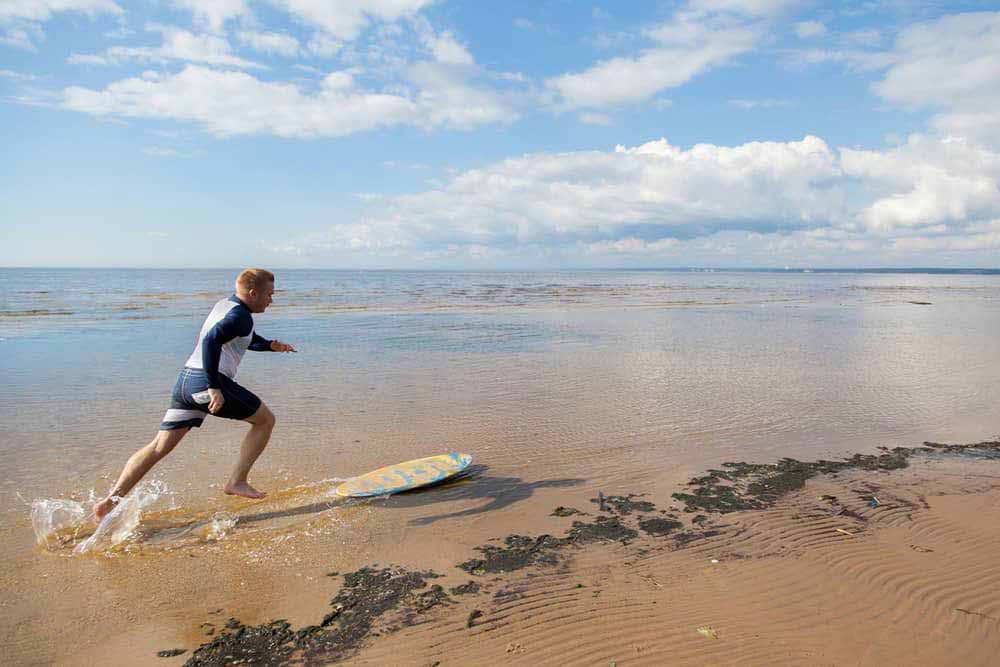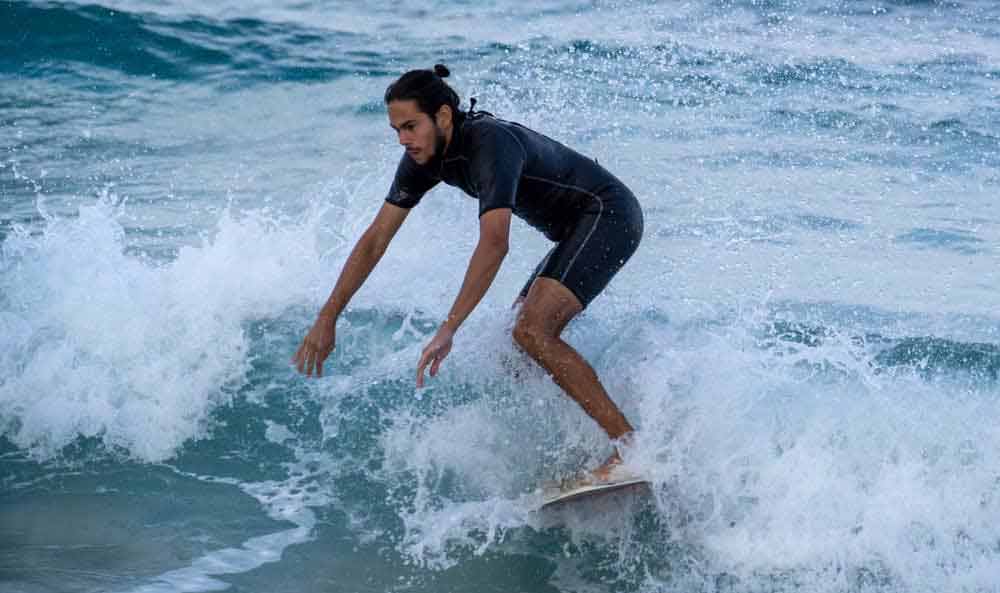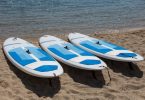If you have a board whether made by yourself or bought from a store and a suitable beach, then you can enjoy the adventures of skimming. Knowing the basic skimboarding tricks will help improve your skills and enhance your safety in the waves. Your level of skill and experience determines the tricks skimboard that is right for you.
Each moment of practice will bring you closer to the pro of your dreams. Before you launch the board, we recommend that you consider the following skimboard tricks.
Skimboarding Tips and Tricks for All
You can perform different tricks on your skimboard despite your level of experience. Once you’re familiar with how to balance on the skimboard, then you’re on the good.
Skimboarding Tricks for Beginners

Here are the basic skimboarding tricks for beginners.
1. Find a Suitable Spot
The water and sand at the beach will serve as your ideal skimboarding environment. Sometimes, you’ll need certain types of beaches based on your skimboarding technique. For example, flat beaches are more suitable for sand skimming. Also, you’ll need beaches with strong shores and steep slopes for skimming in the wave.
2. Buy the Right Skimboard
As a beginner, you’ll learn to select the right skimboard from the stores. Your ideal skimboard is determined by your style of skimming. This is because you’ll need different boards for both sand and wave skimming. For instance, small and flat wooden boards are suitable for sand skimming. While you’ll need a special foam board for wave skimming. Note that foam boards are more expensive than the normal wooden boards.
3. Achieve the Fitness
One of the most important skimboard tips for a beginner is physical exercise and fitness. Like every other sport, you’ll need strength and speed to launch your board in the along the shore. Your success is a function of your wellbeing and agility. You may carry out some daily exercises to achieve the needed fitness.
4. Practice Riding Prior to the First Experience
You can enhance your skimming skills by practicing at a secluded spot on the beach. This is to prevent you from bumping into other people on the beach. This is the moment you’ll learn your favorite pose before striking with the board.
If you’re ready, make a side turn towards the shoreline. Right-footed riders will make a right turn while left-footed persons will turn to the left. Always try to use the angle that you’re comfortable with.
At this stage, you’ll lower your board and lean your body towards the ground. Apply a push force on the board sending it towards the shoreline. These skimboarding techniques will allow you to push the board to the shoreline with little effort. Run to the board, place your foot, and slide along. Repeat this step while gradually increasing your speed to master the art.
5. Take the Right Position
To take your position, hold the board on the tail and on the side. Don’t skim across the sand if the waves are yet to roll out on the sand. Once you notice that all is set, run at full speed with the board. Then, drop the board quickly on the sand.
6. Run onto the Board
After you’d dropped the board on the sand, run towards it and position yourself to jump. Once you jump on the board, ensure that your front leg lands on the middle, and then your back foot follows. The board will skim smoothly if you introduce your body weight gradually. You’ll not enjoy a smooth skim if you jump on the board at once with your two legs.
7. Skim Along
You’ll skim with the board across the sand until it slows and eventually stops. As a beginner, you may want to try other tricks like straight skim, big spin, or shoot. But, you’ll need to master the sand skimming before trying to skim with the wave.
8. Wait for the Right Wave
Sighting the right wave is a sign that you can start skimming. This is a little different from sand skimming as it needs more precision with the wave. You should engage immediately the waves subside. You should take a wave that you can handle without losing balance. Your turning will determine the direction you’re to go with the wave. So, you’ll come after the waves by applying your weight on the outside or inside of the rail-based on your desired direction.
9. Maintain the Proper Speed
The ability to maintain speed is one of the most challenging skimboarding tricks. You’ll achieve speed maintenance by applying the side-slipping method. This involves turning the board to the side on flat water. This method helps to maintain your speed for a long.
Also, you can maintain your speed by using the middle rail of the board. But, this method is a bit difficult since it reduces your level of control over the wave. Be sure to get back to the shore immediately you reach the wave’s front. You may have some difficulties at first but you’ll master the skills after a few trials.
Learning to Skimboard at the Intermediate Level

Now that you’ve got a hang of the beginners’ skimboarding tips and tricks, you can try the following intermediate skimboarding techniques. You’ll notice that some of the skills at the intermediate level are similar to the ones for the beginner.
1. Choose the Right Wave
As we mentioned earlier, it is very important that you choose the right wave. So, how can you determine the wave to choose? The fact is, a suitable wave is one that is within your reach. You shouldn’t ride on waves that are beyond your grasp. Although waves that break to the shore are not easy to ride, they are the best option for you.
Pay attention to the situation of the water at the wave’s front. Watch if the water moves to the sea after the wave. Observe the speed of the water as it’ll determine how fast you’ll run. Water that moves inward at a speed of 5mph will need you to run at a speed of 10mph. Running at such speed will help you to skim at a 15mph wave.
Yet, if the movement of the water is towards the water and at 5mph, you’ll also skim at 5mph. Now, your running speed and your skimming speed will be the same. So, to succeed at this level, you must choose the right wave.
2. Ride Your Board According to Footedness
The speed at which you place your foot on the board during the ride is very important. Sometimes, waves may last for a few seconds, you’ll need to be fast enough to get on the board. As a rule of thumb, step on the board once it touches the sand to begin the ride.
Your footedness will determine which leg lands first on the board. For instance, the right foot will land on the middle of the board while the other foot handles the running motion to maintain the skim speed.
3. Prepare Yourself and Do the Turn
Try to move smoothly into the water to maintain your speed. You can achieve this by putting your weight at the board’s tail. Then, you’ll use your back foot to raise the nose. Once you’re on the water, try to keep your weight at the middle of the board. Improper distribution of weight on the board will bring it to a sudden halt. And, you need to get fit before delving into surfing.
Prepare yourself for the turn as you approach the wave. First, you’ll bend your knees and rest your weight on the board’s back rails. This method tends to limit your speed but you’ll complete the turn if you start on time. Sometimes your hand can serve as a support while you turn in the water.
If you turn on the board, you’ll have enough speed to turn in the wave too. When things do not go well at first, you should try the turn again. If you have the speed, you’re sure to enjoy every bit of turning. This is because you’ll climax at the highest point of the wave. You may get a steady turn at the wave’s front but you’ll change the course at the peak. You’ll achieve this by kicking your back foot at the wave’s peak and returning to the beach.
4. Bring the Board Around
This is another important skimboarding technique for the intermediate riders. You’ll need to understand when the wave is most likely to support your turn. You need to time your moves so that it’ll coincide with the best waves.
We recommend that you snap when the wave is almost breaking. This is because the wave is at its fastest point and moves inward. You can accomplish the move by placing your back foot on the rail to prepare the board for the turn. With regular practice, you’ll save speed when using the board’s side rails for the turn.
5. Come Back Down
Once you’ve completely changed your direction, you’ll now move at the wave’s front. You may decide to turn to continue your ride or turn towards the sand. Also, you may prolong your turn while descending from the wave’s front. This will help you to increase speed while riding on the shoreline. The nose of the board should not point downward while you’re approaching the beach. This is to prevent it from crashing in the sand.
Learning to Skimboard at the Advance Level

You’ll need the following pro skimboarding tricks at the peak level.
1. Spot the Most Opportune Wave
At any level of experience finding the right wave is the most important technique. You’ll need to target a wave that you can reach with ease. At this level, you must have developed the skills to approach the wave at the right angle and speed. Position your board correctly and aim at the wave before it disappears.
2. Jump at the Proper Angle
Before you get to the wave, change your body angle to ride from the side. Try to figure beforehand the right spot to reach the wave. Once you are at the bottom of the wave, lower your body like you’re to jump. The right moment to jump is when your board gets to the lip of the wave.
Try to control your height of the jump by using the bottom of the board. Don’t jump with your two legs at the same time. You can raise the nose of the board if the weight comes from your back foot.
3. Maintain Control Over the Board
You can control the board under your body by sliding your front foot to the upper section of the board. Controlling the board with this method is often difficult. It is the wind beneath the board that’ll keep your feet attached while you turn. You can also control the board by absorbing some of its speed using your knees.
This skimboarding technique will keep your feet attached to the board by balancing the pressure. By bending your knee, the board will be raised under your body during the jump. This will make your landing easy.
4. Extend Your Legs on the Comedown
As you gradually reduce your jump speed, you’ll need to station your feet on the board. Now, you’ll notice that the board will descend. As the board is under your feet, you should widen your legs as you land. Start extending your legs the moment you begin to descend. This is because your legs will be fully extended once you reach the ground. It is important to figure out your best landing spot. It should be safe and free of hazards.
5. Land the Board
At this stage, you’ll have enough experience to land the board with success. Yet, you’ll need some skimboarding tricks to enhance the smoothness of the landing. It is important to focus your weight at the mid-section of the board before you land. Ensure that you position yourself to maintain the needed balance. Finally, you’ll control the impact of the landing by bending your knee.
Safety Tips for the Skimmers
You’ll enjoy your adventure as a skimmer by adhering to the following safety tips.
- Always wear ear protection to prevent damage to the ear when you are riding on a surfboard, skimboard, or bodyboard. Prolonged exposure of the ear to wind and water will dull your hearing. This could result in partial or complete deafness at an advanced stage. So, taking an earplug with you will keep your ear safe.
- You should not choose the wrong-sized board. Choose the right one by using Skimboards Size Chart.
- You should wear sunglasses to protect your eye from the sun’s glare. The reflection of the sun during afternoon hours at the beach could be damaging to the eye. Failure to protect your eye will result in partial blindness or inflammation of the eye.
- Try to exercise the muscles of the knee to reduce stress. This is because a greater pressure on the body while you skim is to the knee muscles. Once you train the surrounding muscles of the knee to handle stress, you’ll feel less pain during and after skimming.
- Try to stretch your back muscles before going on skimboarding. You can set a routine for this exercise. You’ll need to work on your back, arm, leg, abdomen, and shoulder muscles. This will help prevent injuries by strengthening your upper body.
Now that you know the different skimboarding tricks for all skill levels, you’re free to start your skimming adventure. The most important skill to learn is how to catch the right wave. As a beginner, you’ll likely fall off the board a few times. Don’t worry, follow our skimboarding tips and you’ll become a pro in no time.








Leave a Comment